Precautions on supplemental restraint system
This Supplemental Restraint System (SRS) section contains important information concerning the following systems:
- Driver and passenger supplemental frontimpact air bag (NISSAN Advanced Air Bag.
System).
- Front seat-mounted side-impact supplemental air bag.
- Roof-mounted curtain side-impact supplemental air bag.
- Seat belt with pretensioner.
Supplemental front-impact air bag system:
The NISSAN Advanced Air Bag System can help cushion the impact force to the head and chest of the driver and front passenger in certain frontal collisions.
Front seat-mounted side-impact supplemental air bag system: This system can help cushion the impact force to the chest and pelvic area of the driver and front passenger in certain side-impact collisions. The side air bags are designed to inflate on the side where the vehicle is impacted.
Roof-mounted curtain side-impact supplemental air bag system: This system can help cushion the impact force to the head of occupants in front and rear outboard seating positions in certain side-impact collisions. The curtain air bags are designed to inflate on the side where the vehicle is impacted.
These supplemental restraint systems are designed to supplement the crash protection provided by the driver and front passenger seat belts and are not a substitute for them. Seat belts should always be correctly worn and the occupant seated a suitable distance away from the steering wheel, instrument panel and door finishers.
(See Seat belts earlier in this section for instructions and precautions on seat belt usage.)
The supplemental air bags operate only when the ignition switch is in the ON or START position.
After placing the ignition switch in the ON position, the supplemental air bag warning light illuminates. The supplemental air bag warning light will turn off after about 7 seconds if the system is operational.
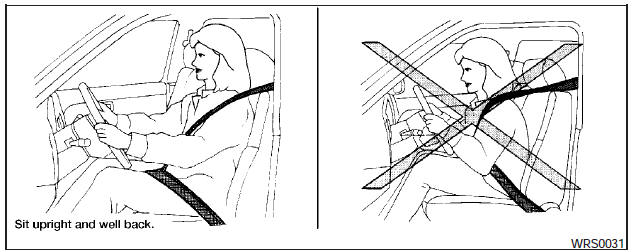
WARNING:
- The front air bags ordinarily will not inflate in the event of a side impact, rear impact, rollover, or lower severity frontal collision. Always wear your seat belts to help reduce the risk or severity of injury in various kinds of accidents.
- The front passenger air bag will not inflate if the passenger air bag status light is lit or if the front passenger seat is unoccupied. See Front passenger air bag and status light later in this section.
- The seat belts and the front air bags are most effective when you are sitting well back and upright in the seat. The front air bags inflate with great force. Even with the NISSAN Advanced Air Bag System, if you are unrestrained, leaning forward, sitting sideways or out of position in any way, you are at greater risk of injury or death in a crash. You may also receive serious or fatal injuries from the front air bag if you are up against it when it inflates. Always sit back against the seatback and as far away as practical from the steering wheel or instrument panel. Always use the seat belts.
- The driver and front passenger seat belt buckles are equipped with sensors that detect if the seat belts are fastened. The Advanced Air Bag System monitors the severity of a collision and seat belt usage then inflates the air bags. Failure to properly wear seat belts can increase the risk or severity of injury in an accident.
- The front passenger seat is equipped with an occupant classification sensor (pattern sensor) that turns the front passenger air bag OFF under some conditions. This sensor is only used in this seat. Failure to be properly seated and wearing the seat belt can increase the risk or severity of injury in an accident.
See Front passenger air bag and status light later in this section.
- Keep hands on the outside of the steering wheel. Placing them inside the steering wheel rim could increase the risk that they are injured when the front air bag inflates.
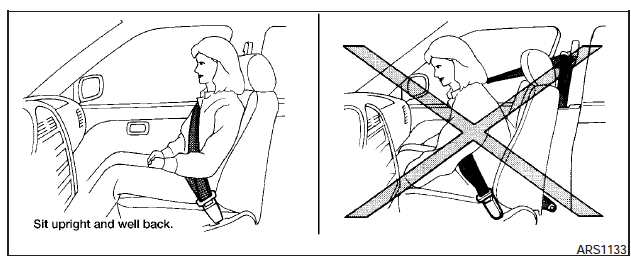
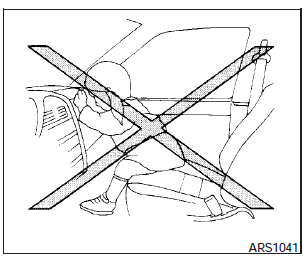
WARNING:
- Never let children ride unrestrained or extend their hands or face out of the window. Do not attempt to hold them in your lap or arms. Some examples of dangerous riding positions are shown in the illustrations.

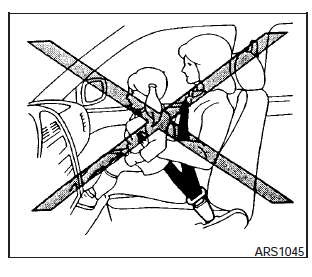
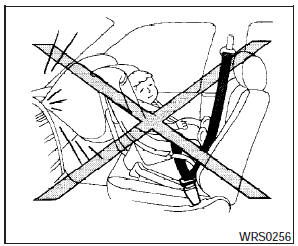
WARNING:
- Children may be severely injured or killed when the front air bags, side air bags or curtain air bags inflate if they are not properly restrained. Pre-teens and children should be properly restrained in the rear seat, if possible.
- Even with the NISSAN Advanced Air Bag System, never install a rear-facing child restraint in the front seat. An inflating front air bag could seriously injure or kill your child. See Child restraints earlier in this section for details.
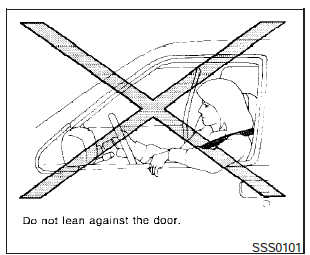
WARNING:
Front seat-mounted side-impact supplemental air bags and roof-mounted curtain side-impact supplemental air bags:
- The side air bags and curtain air bags ordinarily will not inflate in the event of a frontal impact, rear impact, rollover or lower severity side collision. Always wear your seat belts to help reduce the risk or severity of injury in various kinds of accidents.
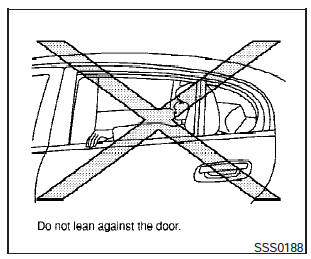
WARNING:
- The seat belts, the side air bags and curtain air bags are most effective when you are sitting well back and upright in the seat with both feet on the floor. The side air bag and curtain air bag inflate with great force. Do not allow anyone to place their hand, leg or face near the side air bag on the side of the seatback of the front seat or near the side roof rails. Do not allow anyone sitting in the front seats or rear outboard seats to extend their hand out of the window or lean against the door. Some examples of dangerous riding positions are shown in the previous illustrations.
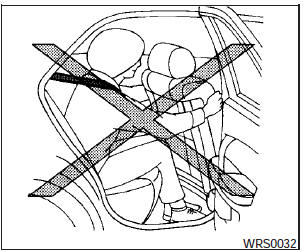
WARNING:
- When sitting in the rear seat, do not hold onto the seatback of the front seat.
If the side air bag inflates, you may be seriously injured. Be especially careful with children, who should always be properly restrained. Some examples of dangerous riding positions are shown in the illustrations.
- Do not use seat covers on the front seatbacks. They may interfere with side air bag inflation.
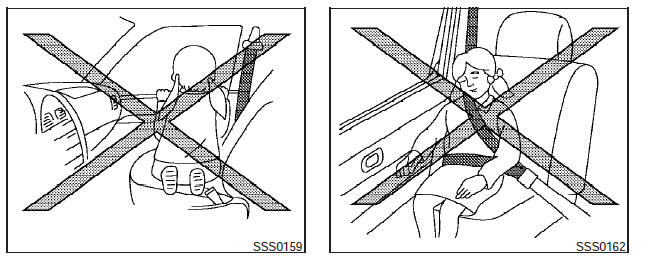
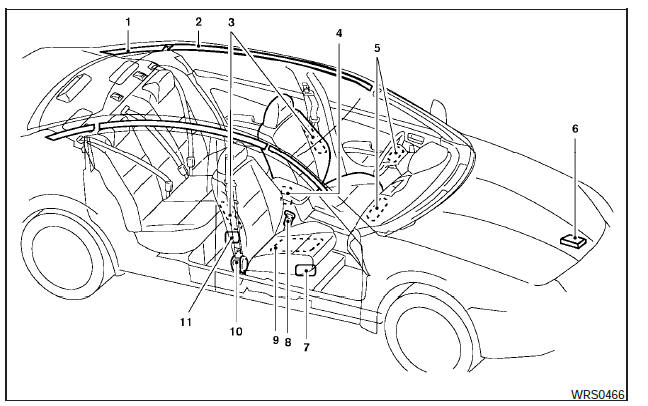
1. Roof-mounted curtain side-impact supplemental air bag inflators.
2. Roof-mounted curtain side-impact supplemental air bags.
3. Front seat-mounted side-impact supplemental air bag modules.
4. Air bag Control Unit (ACU).
5. Supplemental front-impact air bag modules.
6. Crash zone sensor.
7. Occupant classification system control unit.
8. Seat belt buckle switches for drivers and passengers side.
9. Occupant classification sensor (pattern sensor).
10. Seat belt with pretensioner.
11. Side satellite sensor.
See also:
Electric moonroof
Electric moonroof
This moonroof only operates with the ignition
switch placed in the ON position.
NOTE:
If the battery is discharged or is disconnected,
the moonroof may not operate correctl ...
Chrome parts
Clean chrome parts regularly with a nonabrasive
chrome polish to maintain the finish. ...
SENSE AND STYLE
Family Friendly (Not Really, Fair, Great, Excellent): Excellent
Fun-Factor (None, Some, Good Times, Groove-On): Good Times ...
